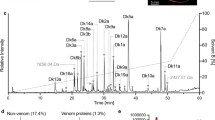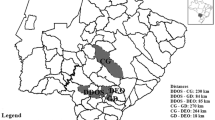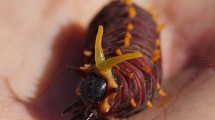Abstract
The chemical contents of three abdominal glands were investigated in representative species of the ponerine ants. The Dufour glands of 14 species show a wide variety of contents. In Mystrium camillae and Proceratium itoi, no volatile substances were found in either the Dufour or venom glands. In Ectatomma sp., Diacamma ceylonense, Diacamma indicum, Pachycondyla obscuricornis, and Pachycondyla striata, volatile chemicals were found in the venom glands as well as in the Dufour glands. Platythyrea punctata was examined, but unusually it does not have a Dufour gland and its venom gland contained no volatile substances. Epoxides were found in ants for the first time in the Dufour glands of Amblyopone reclinata. Venom glands of Pachycondyla tarsata were also found to contain volatile material, including bitter-tasting cyclic dipeptides. In all, 16 species have been added to the list of those examined. All of the 27 known analyses of Dufour glands, 21 analyses of venom glands, and 4 of pygidial glands of workers of ponerine ant species have been brought together in order to seek some pattern in the type of glandular contents. Although the great majority of species produce hydrocarbons in their worker Dufour glands, and some have terpenes, there is no observable pattern for this gland on a tribe or genus level. Volatile compounds have been found in the venom glands of some species of the tribe Ponerini only. The information on pygidial glands is still too fragmentary for any conclusions.
Similar content being viewed by others
References
Attygalle, A. B., Vostrowsky, O., Bestmann, H-J., Steghaus-Kovac, S., and Maschwitz, U. 1988. Pheromones 66. (3R,4S)-4-Methyl-3-heptanol, the trail pheromone of the ant Leptogenys diminuta. Naturwissenschaften 75:315-317.
Bergström, G. and Löfqvist, J. 1973. Chemical congruence of the complex odoriferous secretions from Dufour's gland in three species of ants of the genus Formica. J. Insect Physiol. 14:877-907.
Bestmann, H.-J., Janssen, E., Kern, F., Liepold, B., and Hölldobler, B. 1995. All-trans geranylgeranyl acetate and geranylgeraniol, recruitment pheromone components in the Dufour gland of the ponerine ant Ectatomma ruidum. Naturwissenschaften 82:334-336.
Billen, J. and Morgan, E. D. 1998. Pheromone communication in social insects: sources and secretions. pp. 3-33 in R. K. Vander Meer, M. D. Breed, M. L. Winston and K. E. Espelie, (Eds.). Pheromone Communication in Social Insects. Westview Press, Boulder, Colorado.
Author information
Authors and Affiliations
Corresponding author
Rights and permissions
About this article
Cite this article
Morgan, E.D., Jungnickel, H., Keegans, S.J. et al. Comparative Survey of Abdominal Gland Secretions of the Ant Subfamily Ponerinae. J Chem Ecol 29, 95–114 (2003). https://doi.org/10.1023/A:1021928630441
Issue Date:
DOI: https://doi.org/10.1023/A:1021928630441




